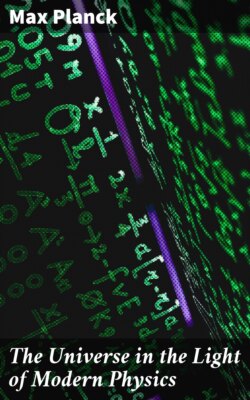Читать книгу The Universe in the Light of Modern Physics - Max Planck - Страница 5
На сайте Литреса книга снята с продажи.
§ 2
ОглавлениеTable of Contents
What changes have taken place in the physical view of the world during the last twenty years? We all know that the changes which have occurred during this period are among the most profound that have ever arisen in the evolution of any science; we also know that the process of change has not yet come to an end. Nevertheless it[Pg 16] would appear that in this flux of change certain characteristic forms of the structure of this new world are beginning to crystallize; and it is certainly worth while to attempt a description of these forms, if only in order to suggest certain improvements.
If we compare the old theory with the new, we find that the process of tracing back all qualitative distinctions to quantitative distinctions has been advanced very considerably. All the various chemical phenomena, for example, have now been explained by numerical and spatial relations. According to the modern view there are no more than two ultimate substances, namely positive and negative electricity. Each of these consists of a number of minute particles, similar in nature and with similar charges of an opposite character; the positive particle is called the proton, the negative the electron. Every chemical atom that is electrically neutral consists of a number of protons cohering with one another, and of a similar number of electrons, some of which are firmly fixed to the protons, together with which they form the nucleus of the atom, while the rest revolve around the nucleus.
Thus the Hydrogen atom, the smallest of all,[Pg 17] has one proton for nucleus and one electron revolving round the nucleus; while the largest atom, Uranium, contains 238 protons and 238 electrons; but only 92 electrons revolve round the nucleus while the others are fixed in it. Between these two atoms lie all the other elements, with many kinds of different combinations. The chemical properties of an element depend, not on the total number of its protons or electrons, but on the number of revolving electrons, which yield the atomic number of the element.
Apart from this important advance, which is however merely the successful application of an idea first evolved many centuries ago, there are two completely new ideas which distinguish the modern conception of the world from its predecessor; these are the Theory of Relativity, and the Quantum Theory. It is these two ideas which are peculiarly characteristic of the new world of Physics. The fact that they appeared in science almost simultaneously is something of a coincidence; for their content, as well as their practical effect upon the structure of the physical view of the world, are entirely different.
The Theory of Relativity seemed at first to introduce a certain amount of confusion into the[Pg 18] traditional ideas of Time and Space; in the long run, however, it has proved to be the completion and culmination of the structure of classical Physics. To express the positive result of the Special Theory of Relativity in a single word, it might be described as the fusion of Time and Space in one unitary concept. It is not, of course, asserted that Time and Space are absolutely similar in nature; their relation resembles that between a real number and an imaginary number, when these are combined together to form the unified concept of a complex number. Looked at in this way, Einstein's work for Physics closely resembles that of Gauss for Mathematics. We might further continue the comparison by saying that the transition from the Special to the General Theory of Relativity is the counterpart in Physics to the transition from linear functions to the general theory of functions in mathematics.
Few comparisons are entirely exact, and the present is no exception to the rule. At the same time it gives a good idea of the fact that the introduction of the Theory of Relativity into the physical view of the world is one of the most important steps towards conferring unity and completeness. This appears clearly in the results[Pg 19] of the Theory of Relativity, especially in the fusing of momentum and energy, in the identification of the concept of mass with the concept of energy, of inertial with ponderable mass, and in the reduction of the laws of gravitation to Riemann's geometry.
Brief though these main outlines are, they contain a vast mass of new knowledge. The new ideas mentioned apply to all natural events great and small, beginning with radio-active atoms emanating waves and corpuscles, and ending with the movements of celestial bodies millions of light-years away.
The last word on the Theory of Relativity probably still remains to be said. Surprises may yet await us, especially when we consider that the problem of amalgamating Electrodynamics with Mechanics has not yet been definitely solved. Again, the cosmological implications of the Theory of Relativity have not yet been fully cleared up, the chief reason being that everything depends upon the question whether or not the matter of outer space possesses a finite density; this question has not yet been answered. But whatever reply is eventually given to these questions, nothing will alter the fact that the Principle of Relativity has advanced the classical[Pg 20] physical theory to its highest stage of completion, and that its world-view is rounded off in a very satisfactory manner.
This fact will perhaps be a sufficient reason for devoting no more time to the Theory of Relativity; I might also point out that there are many treatises on the Theory adapted to the requirements of readers of every kind.
